#frankfurt rhine
Explore tagged Tumblr posts
Text
No12: Hyatt Regency Mainz
I love this hotel. The view from the hotel on the Rhine river will heal you.
#海外旅行#2023 summer vacation#Mainz#overseas trip#frankfurt#Hyatt Regency Mainz#2023海外旅行#ドイツ#マインツ#フランクフルト#ハイアットリージェンシーマインツ#ライン川#rhine river
135 notes
·
View notes
Text
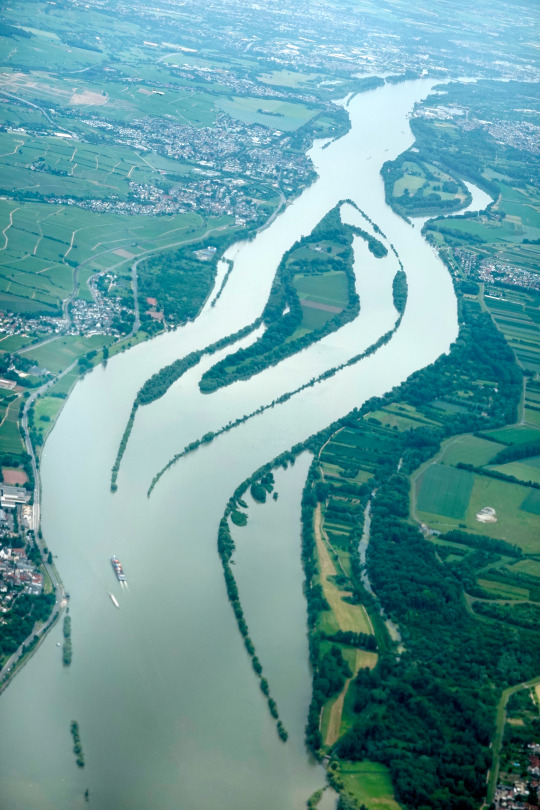
Islands in the Rhine
The islands of Mariannenaue and Königsklinger Aue stand out under the bright reflected sky on an early summer morning, near Mainz, on the flight path to FRA, HS.
#Sony#WalkCam#RX100M6#river#Rhine#Mainz#Frankfurt#FRA#Germany#airplane#window seat#looking down#Hesse
32 notes
·
View notes
Text
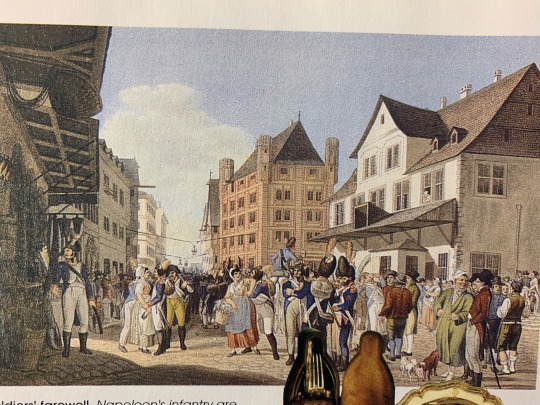


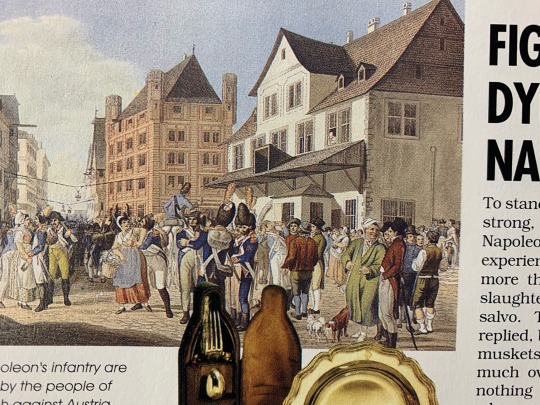
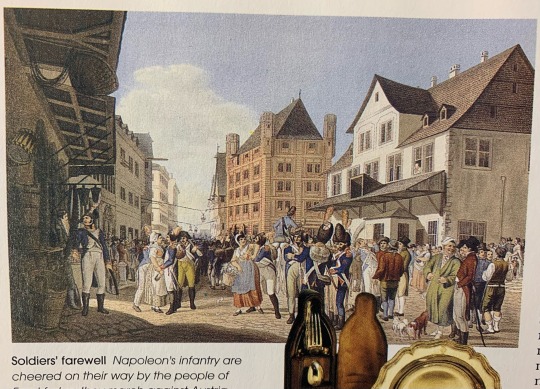
Frankfurt, Germany during the Napoleonic Wars
Source: Everyday Life Through the Ages (Reader's Digest)
#interesting#Frankfurt#napoleonic era#napoleonic#19th century#first french empire#french empire#napoleon#napoleon bonaparte#art#historical art#history#Germany#hre#holy Roman Empire#confederation of the Rhine#france#frev#French Revolution#la révolution française#révolution française#infantry#military uniforms#French history#german history#napoleonic wars#empire#Europe#1800s#early 19th century
34 notes
·
View notes
Text

View of Aachen, North Rhine-Westphalia, Germany
German vintage postcard, mailed in 1902 to Frankfurt am Main
#main#1902#historic#frankfurt#photo#briefkaart#vintage#aachen#north rhine-westphalia#sepia#westphalia#photography#carte postale#north#postcard#mailed#postkarte#postal#tarjeta#ansichtskarte#view#old#ephemera#postkaart#rhine#german#germany
6 notes
·
View notes
Photo

Frankfurt's "old town", somewhat controversially rebuilt from the ashes in recent years. . . 🇩🇪 🚙 🏛️ . . #travel #travelgermany #germany #rheinland #ドイツ #キャンプ #キャンパス #camping #motorhomelife #campinglife #summer #deutschland #rhine #ライン #frankfurt #gothic #medieval #medievalarchitecture #建築 #歴史 #フランクフルト #oldtown #renovated #townsquare #streetscape #altstadt #tenement (at Frankfurt, Germany) https://www.instagram.com/p/Cln0GmOISGT/?igshid=NGJjMDIxMWI=
#travel#travelgermany#germany#rheinland#ドイツ#キャンプ#キャンパス#camping#motorhomelife#campinglife#summer#deutschland#rhine#ライン#frankfurt#gothic#medieval#medievalarchitecture#建築#歴史#フランクフルト#oldtown#renovated#townsquare#streetscape#altstadt#tenement
1 note
·
View note
Text

Eltville - rhine river - Germany
youtube
#Eltville#rhine#rhein#romantische rhein#romantic rhine#visit germany#germany#deutschland#road trip#vacation#holiday#travel#architecture#wiesbaden#mainz#frankfurt#koblenz#wine#wine region#relaxing#europe#Youtube
1 note
·
View note
Text
The shapes of railway networks
A while ago @ariadsishereagain asked me about countries that have no railway networks, and what I think of them. That's a fascinating question that has been in my mind ever since, because the truth is you can tell a lot about a country and in particular it's history during the 19th and early 20th century by its railway network. So let's do that. And the best way to do that is by looking at the incredibly detailed open-source world railway map OpenRailwayMap, a part of the OpenStreetMap project. I really recommend it! And let's start with one of my favorite examples of how railway networks differ:

At this zoom level the site sadly only shows incomprehensible internal abbreviations rather than city names, so let me explain: What we have here are France and Germany, along with some of the UK and Italy, some of various neighbouring countries and all of Switzerland, Belgium and Luxembourg.
France and Germany are the ones that I find the most interesting, because the shapes of their networks are so different. Not only is the german one much more dense, but you can see completely different patterns.
In France, the job of railroads is to bring people to Paris (PLY, short for Paris Gare de Lyon) The lines stretch out into every part of the country, but almost all of them converge onto mainlines going into Paris. You can see some lines along the coasts and the borders, and there is a medium distances circle around Paris (passing MZ, DN, TO, short for Metz, Dijon, Tours). This whole pattern is known as the Legrande Star, after Baptiste Alexis Victor Legrande, the french government official who designed it. His goal was to provide great access to Paris, the nation's undisputed political, cultural and economical centre. A couple of decades later, Charles de Freycinet added plans to connect all departments to the railway network, but he still followed the idea that the ultimate goal of almost every rail line was Paris. And so it was, and largely remained. Even the high speed lines, in red, follow this pattern to this day.
A result is that you will have to go to Paris whether you want to or not. Lille-Strasbourg? You're going through Paris. Bordeaux-Dijon?
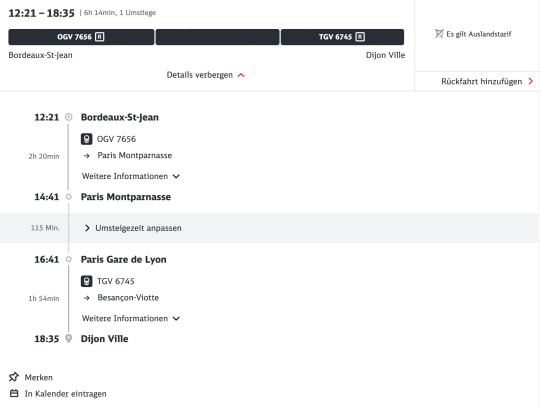
You're going through Paris, and get to make your own way from Gare Montparnasse to Gare de Lyon on the Metro (and it isn't even a direct metro, you have to change trains). It's a massive detour but it's not like you have a choice.
Even if there is a direct TGV or a connection outside the main stations of Paris, you're still ending up very much near Paris; the difference is just that you're not going via the city centre, but rather via Disneyland. Legrande wanted to bring people to Paris; he was less concerned about connecting other places with each other.
Now compare Germany, and you will see a network that is more dense, but most importantly, utterly chaotic. You can see hints of a France-like star around Berlin (BSPD, short for Berlin Spandau, which isn't the most important station but what can you do), but it's really only dominating its immediate surroundings, the region of Brandenburg. You can see vague hints of a similar star around Hamburg (AH; don't ask) or Munich (MH), but also a massive tangle around the Rhine-Ruhr industrial area (around KD), or around the Frankfurt am Main area (FF). Red high speed lines are essentially random. Some of them do go to Berlin, sure. But many, like the one from Cologne to Frankfurt (KD to FF) or the one from Hanover (HH) south, do not.
And that really reflects the history. Germany wasn't a unified country when railroad construction began, and even though it did unify shortly thereafter, there's no hiding that its different parts developed separately, with no central planning, ever since the middle ages. Germany doesn't have a single central city like France. Berlin is the biggest and most important city, but not by far. Hamburg has huge cultural and industrial influence, Frankfurt is the most important financial centre and airport, Munich is huge, and there are agglomerations like the Rhine-Ruhr region that used to beat all of them in terms of industry. And the rail network, with no single central focus point, reflects that.
That doesn't mean Germany doesn't have its own blind spots. Due to being split in two, the east-west links aren't great. Getting e.g. from Cologne (near KD) to Dresden (DH) is pretty painful. Ironically, Berlin is one of the places that really suffers from this. There are plenty of trains to it from Cologne but they take forever, and you can see why: A lot of the route isn't high speed, it's just more or less upgraded normal lines. If you have a single destination, then it's easy to build all the lines there. If you want high-speed connections between everything, that's more difficult. (Also, our government isn't investing anywhere near enough into the rail network, both compared internationally and on its own terms, but that's a different issue)
Other countries in Europe tend to be somewhere between the extremes. Spain is fairly centralised around Madrid.
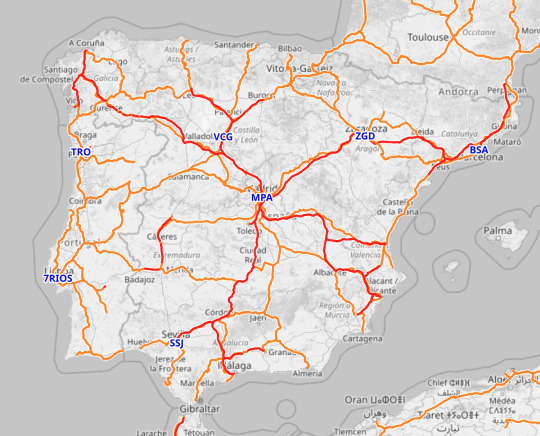
The UK is just as focused on London as France is on Paris, but it has strong regional networks around Leeds and Sheffield, and the weirdness in Scotland (four different lines between Glasgow and Edinburgh and counting!).
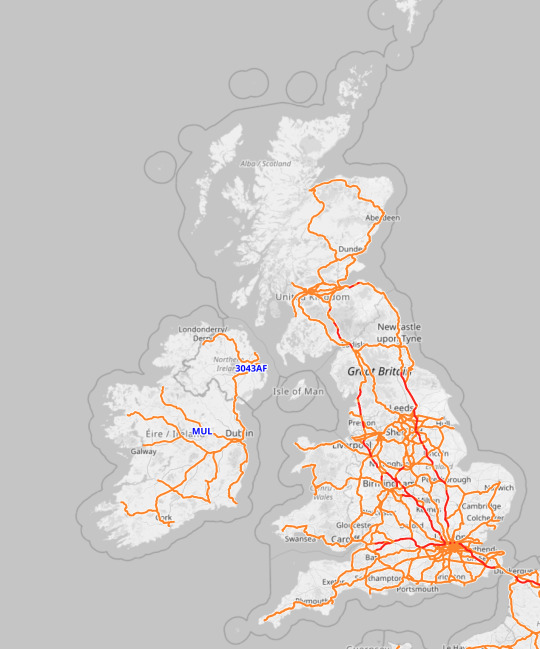
Italy, especially south of the Po valley, almost looks like a ladder: Lines are either on the one side of the Apennines or the other, with a few brave ones crossing through.
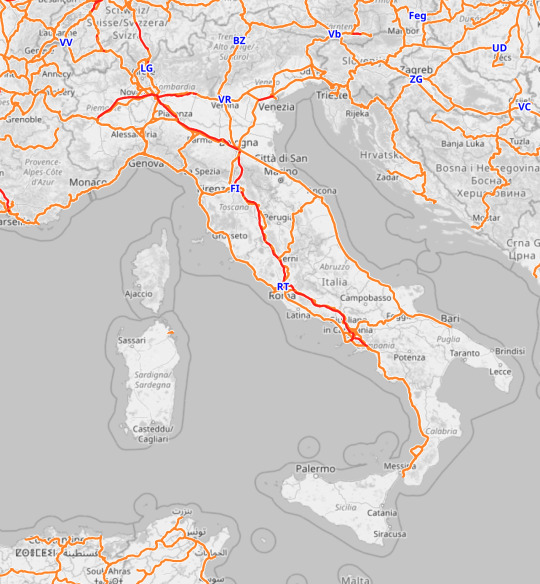
This works overseas as well. Describing the continental US as "like Germany" is certainly going to raise some eyebrows, but the map doesn't lie:
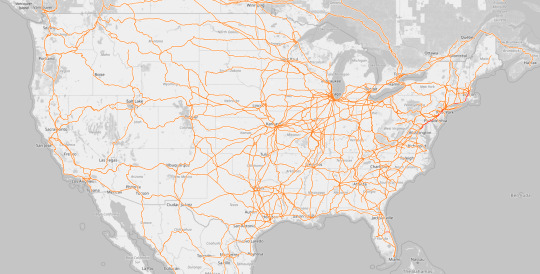
It's all on a completely different scale, but it's also a federal country with no one single clear centre. Yes, New York and Los Angeles are big and important, but neither is an all-powerful centre of the nation. What's fun about the US is that it's almost gradient-like: The more west you go, the fewer the railroads get. You can also nicely see the Alleghenies by the shadow they cast: Just a few brave rail lines managed to make their way through or around. Other characteristic items are the huge tangle that is Chicago, the closest thing the US has to a railroad capital; and the many places where lines are almost duplicated (just count how many different ways you can get from Chicago to Memphis, or Chicago to Cleveland), thanks to different competing railway companies that all hated (and sometimes still hate) each other's guts.
So that's what's mostly considered the "western world" or "industrialised world". I skipped Japan, China and India because the post is going to get too long no matter what, but they're all fascinating as well.
But if we go away from there look at countries where the colonialism was less settlers and more exploit mostly from afar, we see another very odd pattern emerge, like here in sub-saharan Africa:
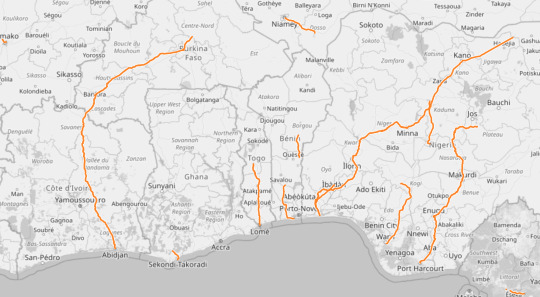
The selection is somewhat arbitrary because you can find the same pattern everywhere south of the Sahara, and in one case (Mauretania) even in the Sahara: A railroad that goes straight to the coast. (The isolated sections inland are due to issues with the map software, they're all connected to one of the lines to the coast)
This kind of railroad is designed to extract a country's resources, and not much else. In Mauretania (not in this picture), that's iron ore. Elsewhere it might have been other ores, precious metals, gemstones, but also very often agricultural products, spices, dyes. The railway line exists to take these things, and bring them to a port. The line is not designed to actually help the nation grow economically. Think about it: All things being equal, you're probably just as likely to want to go parallel to the coast as perpendicular to it.
Also, each of these lines were built because there's something interesting at the end of it, or at least someone suspected there might be. If you wanted to develop the area, it would make sense to trade the interesting stuff in Togo with the interesting stuff in Benin. But the railway lines are not set up for that at all. The goal is to get the interesting stuff to a ship, and occasionally soldiers to the place where the interesting stuff comes from.
These days, the area that I screenshotted here is actually massive, full of people. The city of Abidjan has more than four million inhabitants (more than Berlin), Lomé has 1.7 million, Cotonou and Porto-Novo come close to a million if taken together, and nobody's quite sure about Lagos, but it's at least 14 million, and the metropolitan region might be 24 million. This is a band of cities that researchers think might, in the next few decodes, become on par with Washington-Philadelphia-New York-Boston in the US, or the Tokyo-Osaka in Japan.
And the rail connections in this region do not reflect this at all. A high speed passenger line and/or a heavy duty freight line could allow all these places to do business with each other, allow people to move to or visit each other, and just spur a lot of economic development. But the powers that built the lines, the colonial powers, were not interested. They had their harbour, and the region behind it, and they just wanted to extract whatever was there.
To be clear, that does not mean the railroads are evil now. Selling natural resources is still better than bringing no money into the country. And there are a lot of places where railroad junctions and depots became the point where cities were founded, so in some countries these lines do end up connecting the most important cities, more or less by accident. It's just that other lines or more lines are sorely missing.
A simple example for how this could look like is provided by Australia, where the colonists were settlers and did want to develop the land economically:

You have the lines from the coast inland, and sometimes quite a lot of them. But you can also see a line along the east coast, connecting the cities, and you can see that someone said "we need to build a railroad across the entire continent. No, two actually". That is not to say that Australia does everything right with railroads, they have a lot of weirdness there. But you can see that the railroads had more jobs than to just move resources to ships.
(The big exception is the Pilbara region, in the north west, with its odd tangle of lines. Those are all just resource extraction lines, where the world's heaviest freight trains haul iron ore from various mines to various ports. The mines and ports are owned by different mining companies that don't like each other, so everybody has their own line from their own harbour to their own mine, even if a different line would have been shorter. That's why you get the tangle there.)
So, that's basically it. The railroad map of a country shows you a lot about how a country works, and more specifically how it worked during the late 19th and early 20th century, when most railroads were built. Where they lead to and where they don't reflects what planners thought of as important, and in turn, it has shaped the way these countries developed. And personally, I always find this endlessly fascinating.
#railroads#maps#i suppose you could take the 6 to bercy and walk from there but it's still not exactly convenient
300 notes
·
View notes
Text
Outing / Exposure / Blackmailing
Masochistische TV-Sklavin aus dem Raum Frankfurt/Rhein Main sucht sadistische Dominanz, tabulose Konsequenz und extreme Demütigung auch öffentlich - psychischer Druck, Torture Interogation, Outing, AirTag-Stalking.
Ich möchte als Schwuchtel und Transe in alles sozialen Internetforen bekanntgemacht werden.
Bitte um extreme Outing / Exposure / Blackmailing
Outing/Exposure/Blackmailing
Masochistic Trans-slave from the Frankfurt/Rhine Main area seeks sadistic dominance, taboo consequences and extreme humiliation, even in public - psychological pressure, torture interogation, outing, AirTag stalking.
I want to be known as a fag and a tranny on all social internet forums.
Request extreme outing/exposure/blackmailing

#outing#blackmail#chastity humiliation#locked in a cage#humiliation chastity#keyholder#forced femizination#forced chastity#humiliation slave#fully exposed and ruined#public exposure#exposed and outed
24 notes
·
View notes
Text
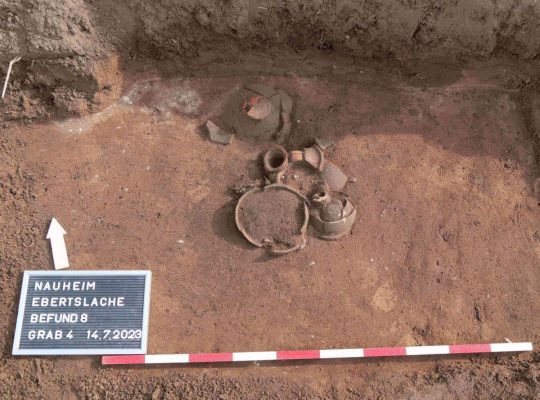
Roman-Era Burials Discovered in Germany
Students from Goethe University Frankfurt, in collaboration with the Hesse archeology department at the Darmstadt branch of the State Monument Protection Agency, uncovered 46 graves from various ethnic groups near Nauheim, a town southwest of Frankfurt in the central-western German state of Hessen.
They uncovered 46 graves from the time when Roman legions were stationed on the Rhine during a six-week training excavation. The grave goods indicate the deceased were immigrants with Gallic funerary customs who settled in the area in the middle of the 1st century A.D.
The team expected to find Roman remains because a Roman military camp was known to have been built in the Nauheim area. The graves of early settlers came as a surprise.
The burial ground, which eight students in two teams brought to light on a good 2,000 square meters, dates from the middle of the 1st century AD to the beginning of the 3rd century. They unearthed a total of 46 graves, 44 of them cremation burials, only two of them inhumations.
Anthropologists will now examine the bone remains from the corpse fire as well as the skeletons and determine the age at death, gender, and diseases.
The Nauheim graves show who settled on the borders of the Hessian Ried almost 2,000 years ago: immigrant ethnic groups in small-scale groups. Grave goods indicate Germanic military farmers who were deliberately attracted by the Romans from the north, took over the security service in the province on the border of the Roman Empire, and then settled down.

In the burial area, a 30-centimeter high vessel, in particular, indicated that the dead of newly arrived settlers found their final resting place here: a bronze bucket that probably served as a burial urn.
An early Nauheimer “in the bucket”. Burying a person in a bronze bucket and providing tools such as scissors or knives is atypical for Roman burials. This is also the first time that evidence of the grave enclosures mentioned has been found in southern Hesse, while the custom was widespread on the left of the Rhine in the east of Gaul in the late Iron Age (1st century BC) and the 1st century AD. For scientists, such unusual burials are clear signs that immigrants were buried here, bringing not only their culture but also their burial rites with them.
The bucket must have been imported here and probably cost a dinar or two,” said Professor Markus Scholz, head of the Archeology and History of the Roman Provinces course at Goethe University. In general, the grave goods – such as a complete urn made of green glass – were of high quality, which indicates a certain level of wealth of those buried.
There are also six rectangular ditch systems that can be viewed as the enclosure of special burials and, according to current knowledge, all belong to the burial ground’s founding phase. In some cases, there are additions such as a complete glass urn, which attest to the wealth of those buried.
By Leman Altuntaş.
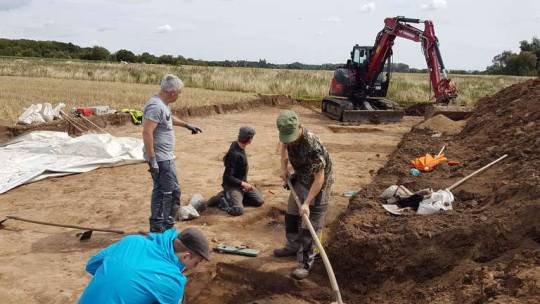
#Roman-Era Burials Discovered in Germany#Nauheim Germany#Hessen Germany#ancient graves#ancient tombs#ancient artifacts#archeology#archeolgst#history#history news#ancient history#ancient culture#ancient civilizations#roman history#roman empire
44 notes
·
View notes
Text
FRANKFURT (Reuters) -German police said they were holding a 26-year-old Syrian man in custody on Sunday after a knife attack in the city of Solingen in which three people were killed and eight injured, adding that they were looking into the suspect's possible links with Islamic State.
The incident, along with the militant group's claim of responsibility, sparked concern among some politicians who urged enhanced security, tighter curbs on weapons, stiffer punishment for violent crimes, and limits to immigration.
The attack occurred during a festival on Friday evening in a market square where live bands were playing to celebrate Solingen's 650-year history. Mourners made a makeshift memorial near the scene.
The suspect turned himself in late on Saturday and admitted to the crime, Duesseldorf police and prosecutors said in a joint statement early on Sunday.
German federal prosecutors identified the Syrian man as Issa Al H., omitting his family name because of German privacy laws, and said he was suspected of being a member of Islamic State.
Prosecutors said "due to his radical Islamist convictions" he tried to kill as many people as possible that he considered to be non-believers, stabbing them repeatedly in the neck and upper body.
Friedrich Merz, a prominent politician who leads the opposition, centre-right CDU party, said the country should stop admitting further refugees from Syria and Afghanistan.
"It's enough!" he said in a letter on his website.
The suspect came from a home for refugees in Solingen that was searched on Saturday, North Rhine-Westphalia's interior minister, Herbert Reul, said.
Der Spiegel magazine, citing unidentified security sources, said the suspect had moved to Germany late in 2022 and sought asylum.
The Islamic State group described the man who carried out the attack as a "soldier of the Islamic State" in a statement on its Telegram account on Saturday.
On Sunday, the group posted two clips on its Telegram account of what it said was the attacker. The first purportedly showed the masked man pledging allegiance to the Islamic State leader, and the second, in which his face was blurred, allegedly showed him speaking moments before the attack.
Hendrik Wuest, premier of the state of North Rhine-Westphalia where Solingen is located, on Saturday described the attack as an act of terror.
Germany's Federal Criminal Police Office (BKA) has said there have been around a dozen Islamist-motivated attacks since 2000. One of the biggest was in 2016, when a Tunisian drove a truck into a Christmas market in Berlin, killing 12 and injuring dozens.
"The risk of jihadist-motivated acts of violence remains high. The Federal Republic of Germany remains a direct target of terrorist organizations," the BKA said in the report earlier this year.
7 notes
·
View notes
Text
Roman holiday
Max had been given a tour of Germany by his German-born grandmother as a graduation present. He flew to Frankfurt and was to travel from there through the Rhine Valley to Cologne. From there it went on to Hamburg, Berlin, Dresden and to Munich. At the end, a week of skiing in the Austrian Alps was planned.
Max liked the first stop, Frankfurt, very much. Thanks to the generosity of his grandmother, he stayed in an excellent hotel. And after the first evening, he had made friends with the handsome bartender. Max had once been quite athletic, but during his studies, sports had suffered. So it did him good to be able to flirt despite his belly.
Two days before leaving for Cologne, Max went over his travel plans again at the bar. He barely understood a word of German, and he didn't really understand the confirmation of the hotel located directly on the Rhine. He held out his cell phone to the bartender and asked if he could explain to him what was in the booking confirmation and, above all, why the nights were so insanely expensive. Max was paying more than double what he usually had to pay on his tour of Germany. "Guy, are you seriously asking me that?" the bartender replied. "I thought you were going to Cologne specifically for Carnival. Very different from New Orleans or Rio, but the biggest party Germany. And your hotel booking includes admission to one of the hottest costume balls." The bartender pulled out his cell phone and showed Max a few photos from his last trip to Cologne Carnival. "I'm really jealous. There are some really hot lads in town that weekend. You're going to have your fun. Do you have a costume yet?" Max replied in the negative and the bartender played with his cell phone a bit. "Here, what do you think of this? Roman Legionnaire. Cologne is a Roman foundation, so that fits. And you'll look hot in that costume!".
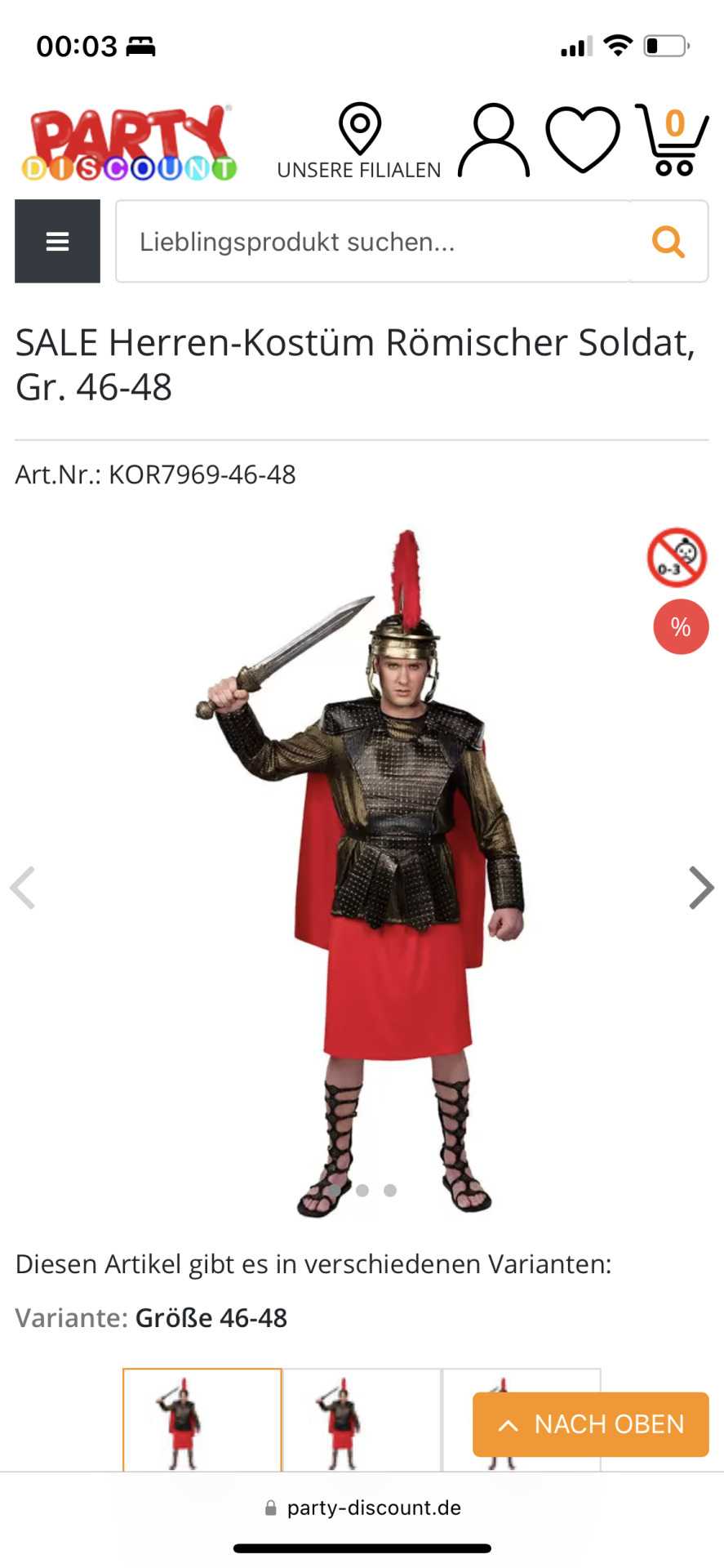
The price was really reasonable, Max accepted and the bartender ordered directly with delivery to Max's Cologne hotel.
When Max arrived at his Cologne hotel on Saturday afternoon, there was already a party atmosphere. The foyer was decorated and hardly a guest was walking around without a costume. Max checked in and was informed that his package was already in his room and that the costume ball would start at 7:11 pm. "Strange time," Max thought to himself. But this was a weird town, too. Max moved into his room, unpacked his suitcase and then opened the package. Shit, that wasn't the costume he ordered. This one looked more elaborate. But it also showed much more skin. Too much skin for Max's taste. Max tried to combine the costume with a t-shirt, but that looked even goofier. Well, thanks to the helmet, no one would be able to recognize him. And he wouldn't be at the party for long anyway.
At 7:30 p.m. Max put on the cape and headed for the elevator. In the hotel hallway, he was met by several other guests in a party mood. Almost everyone stared at him or turned to look at him. In front of the elevator, the stares of the other guests made him almost uncomfortable. Then the elevator doors opened. And Max stared at his reflection. He was no longer Max. He was Maximus!

What a party…! It was 02:00 in the morning and Max needed a cigarette. His transformation had been complete for a long time. He had gained several more pounds of muscle. And his costume had also changed. Instead of plastic, it was now made of high-quality leather. And his cape was no longer made of polyester but of a heavy loden fabric. Max stepped in front of the hotel, where hundreds of people were smoking and drinking. He took off his heavy metal helmet and asked the muscular Viking next to him if he could have a cigarette. "A kiss first, Centurion," was the reply. The crowd roared as Roman and barbarian stuck their tongues deep down each other's throats. Carnival had just begun. And promised to be a lot more fun.
@axeegliter, always a pleasure to accept your challenges!
97 notes
·
View notes
Text

Tapestry, Middle Rhine area to 1410-1430
Museum of Applied Arts, Frankfurt, Inv. No. 6809
9 notes
·
View notes
Photo

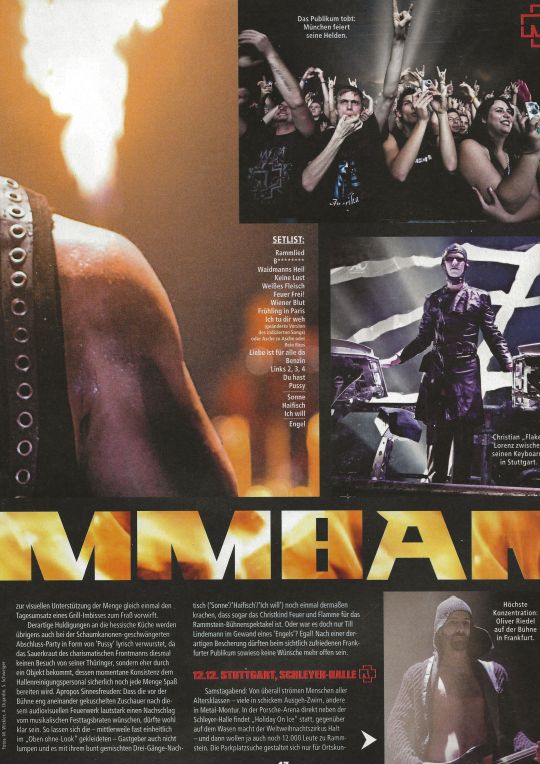

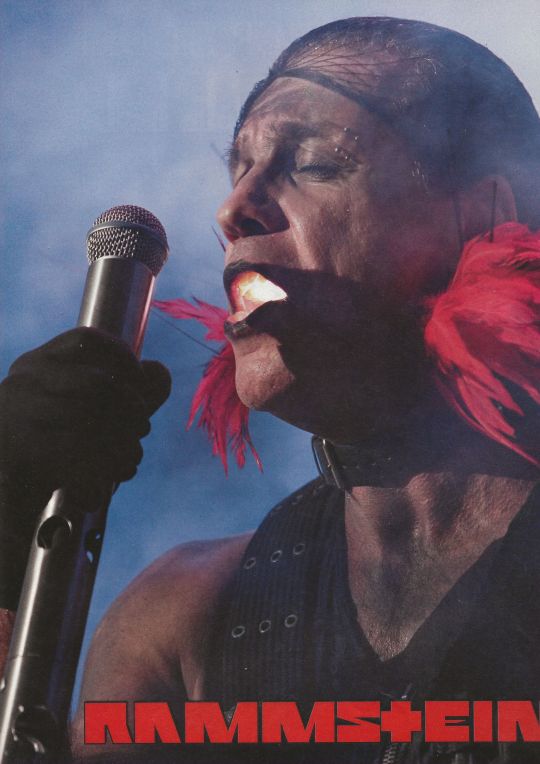
Metal Hammer - February 2010
The spectacle continues: Rammstein pull a fire trail through Germany with their Liebe ist für alle da tour. After Metal Hammer dedicated itself to three concerts in the previous edition, the journey now continues to Frankfurt, Stuttgart, Hamburg and to the home game in Berlin. Did only the stage burn on site or did the audience as well?
11.12. Frankfurt, festival hall
It's December 11th, 2009. The whole Rhein-Main area is infected by the Rammstein virus! The whole Rhine-Main area? No! But in order to make at least a small part of this diagnosis, you don't need a doctorate these days. Hundreds of party-mad Rammstein fans transform the extensive area in front of the magnificent Frankfurt Festhalle into their very own Christmas market. Here - punctually until the first chime - the merchandising bus is on the lookout for a gift for loved ones, people ask for admission to the Holy of Holies at the gates of (heaven) or at one of the countless stands the cold season with delicious mulled wine neutralized. The only difference to Nuremberg, the capital of Christkind: Here, instead of 'Last Christmas' or 'Jingle Bells', it's mainly these that get through.
Big hit from the Berlin scene institution from the Munich of the proud ticket holders. ‘Silent Night’ is definitely different.
In the circus ring-like interior of the location, the first thing to say is: wait for the Christ Child. Instead of shortening the whole thing with a speech by the Federal Chancellor, the industrial rockers from Combichrist try to heat things up today - which, however, meets with a similar amount of enthusiasm from large parts of the audience. Whether that's why the dedicated Norwegians chose their catchy tune 'WTF Is Wrong With You People?' as the official end of their tryst is anyone's guess.
After that, it's finally time for tonight's main attraction. With their spectacular debut, they immediately gave the term 'Freemasonry' a new definition. However, even such rock light figures as Rammstein - as in most tour stations before - need a two-part start-up phase ('Rammlied'/B******') at the beginning until the first decent cracker of the evening. Such explosive titles can be taken literally, because when the attack is blown with 'Waidmanns Heil', not only the pyro effect premiere heats the mood barometer up to the boiling point. Since the set list of the six capitals is identical to the previous gigs of the tour, the band's Die Hard fans are particularly excited about the 'polarizing' anthem 'Ich tu Dir weh' and the answer to the question 'How do Rammstein avoid the indexing this time? '. And how do the Neue Deutsche Härte initiators solve this problem? Actually as always: Namely with their very special sense of humour. Instead of singing about urinary canals, Till prefers to sing about other messes in the form of Frankfurter sausages, of which he immediately throws the daily turnover of a barbecue snack to the crowd for visual support.
Incidentally, such homage to Hessian cuisine is also lyrically spoiled at the foam cannon-laden closing party in the form of 'Pussy', since this time the charismatic frontman does not receive a visit from his Thuringian, but rather from an object whose current consistency resembles the hall cleaning staff will certainly be a lot of fun. Speaking of sensual pleasures: it should be clear that the audience, whispering close together in front of the stage, loudly want a second helping of the musical festive roast after this audiovisual firework. The hosts — who are now almost uniformly dressed in a 'topless look' — don't splash out either and let it rip with their colorfully mixed three-course dessert ('Sonne’/‘Haifisch’/‘Ich ‘will). that even the Christkind is hooked on the Rammstein stage spectacle. Or was it just Till Lindemann in the guise of an ‘Engel’? Doesn't matter! After such a mess, the visibly satisfied Frankfurt audience should have nothing to wish for anyway.
12.12. Stuttgart, Schleyer Hall
Saturday evening: People of all ages stream from everywhere — many in smart endured thread, others in metal gear. 'Holiday On Ice' takes place in the Porsche Arena right next to the Schleyer Hall, opposite on the Wasen the world Christmas circus stops - and then 12,000 people also want to see Rammstein. The search for a parking space is only unproblematic for those who know the area. It's cold outside, freezing cold even, so the anticipation of a warming pyro inferno increases even more. Although admission is from 7 p.m., there is still a very long queue just before 8 a.m. Everyone is shivering, teeth are chattering, deposit collectors are loading plastic bags and shopping carts full, the atmosphere is relaxed and peaceful. Wearers of glasses are also safe, because VfB-Wüterich Jens Lehmann is already in Mainz to prepare for the game against FSV.
Due to the barcode check of the tickets and precise scanning controls, progress towards the hall entrance is very slow. What seems annoying when queuing in the freezing cold turns out to be a stroke of luck. At least for those who no longer have to endure the entire Combichrist performance. The first few rows still seem to like it — it's all a matter of taste.
It gets dark at 9 p.m. sharp and Rammstein break through the stage decorations to greet the audience with 'Rammlied'. During ‘Waidmanns Heil’ — a real hit live — the first pyros take to the air. The interlude in ‘Feuer Frei!’ is also cool, when singer Till and guitarists Richard Z. Kruspe and Paul H. Landers form a triangle and spit fire with flamethrowers. ‘Wiener blut’ is disturbing. The stage is decked out with baby dolls on meat hooks. The babies burst, the lights go out and the relaxing sounds of ‘Frühling in Paris' ring out. So far it's an extremely atmospheric show, which unfortunately suffers a bit from the heavy, undifferentiated sound. This not inconsiderable shortcoming is eliminated from ‘Asche zu Asche’. Yes, that's right, 'Ich tu dir weh finally flies out of the set list in Stuttgart and is replaced by 'Asche zu Asche'. Good thing, because this song is better anyway.
From now on the guitars finally riff powerfully and vehemently with an overwhelming sharpness. Keyboarder Christian ‘Flake’ Lorenz climbs into a container, onto which Till fires volleys from a pedestal several meters above the ground until said container explodes. Seconds later Flake gets up in a glittery silver costume and takes his place on a treadmill in front of his keyboard. Cool. 'Benzin', with a low-squatting and wildly banging Till, is another high point until the band march out of the retractable floor onto the boards in lockstep on 'Links 2 3 4'. In contrast to earlier days, Rammstein exude enormous joy in playing. The consistently agile musicians communicate on stage and, despite the tight, rigid choreography, present themselves in a relaxed and sympathetic manner. No sign of static. And that, although it certainly requires enormous concentration in order not to be charred by the pyros fired from all possible corners of the stage, which is multifacetedly illuminated.
During ‘Du hast’, the audience, who is becoming more and more euphoric every minute due to the increasingly dramatic show, ducks their heads to avoid a ‘boomerang arrow’ shot by Till. The well-known encores with Flake's rubber dinghy ride during 'Haifisch' and the brilliant finale 'Engel' end a rousing concert by what is probably the most entertaining and entertaining live band on the entire music scene at the moment. Richard Kruspe jumps into the ditch to shake hands. Rammstein are not as aloof and distant as they often seem. When Till finally says goodbye to the exhausted crowd with his first announcement, 'Thank you for the wonderful evening, Stuttgart', you don't have to be a mentalist to read the audience's thoughts: 'You're welcome. All ours.'
14.12. Hamburg Color Line Arena
The Hanseatic city of Hamburg has always been a good place for the heroes of German rock music. Like every concert on this tour, the Color Line Arena right next to the HSV stadium is of course completely sold out. A good 12,000 Rammstein fans - that looks like something. To use the time until the Rammstein gala sensibly, there are two options tonight: Either you watch Combichrist, or you refresh yourself with delicious local beer specialties. In Hamburg they are called Holstein. The bulk of the 12,000 rodent collectors agree to do both, although the interior space is still noticeably thinned out.
Quite different then at 9 p.m. sharp. When the protagonists 'sweat' their way through the papier-mâché wall and are illuminated from behind with an estimated 6,000 watts, the cheering in Hamburg knows no bounds - just like in every city. Rammstein know how to present themselves and are successful every time. Compared to previous tours, there is a little less fire and pyrotechnics at the start, but that's whining at a high level, after all there are few or no bands that can even remotely match Rammstein in terms of show.
And the sextet also has great songs. As with some concerts on the current tour, the sound had to be adjusted a little during the set in Hamburg, because Till's singing came across as a bit undifferentiated. However, those responsible for the Rammstein live sound have this under control very quickly. In this way, no questions remain unanswered, because the answer is always: Rammstein.
Although: That's not entirely true... Question one that he needs to clarify: Are Rammstein playing 'Ich tu dir weh’ again today? Answer: No, unfortunately not - but 'Asche zu Asche' is certainly one of the biggest songs in the Rammstein canon, so that there is only limited scope for complaining.
The following explanation on this subject was posted on December 12, 2009 on the Rammstein Facebook page: « From today on, the instrumental version of 'Ich tu dir weh' will no longer be performed in Germany, since access to the concerts restricted to persons under 18 years would otherwise not be permitted. » Question two, and that's also the case throughout the tour: Do eight (!) new songs really have to be in a 90-minute set? Sure, as a musician you want to play your new material specifically, but there's no denying that so many other hits fall by the wayside. No 'Moscow', no 'Americk’, no 'Mein ‘teil, no 'Mein herz brennt’, no ‘Du riechst so gut’, no ‘Heirate mich’ - the list could go on and on.
Keyboarder Christian 'Flake' Lorenz cannot be at the show today due to an infection. Till Lindemann speaks to the audience personally and does the customer service, but also says that the show was not to be canceled under any circumstances. Alf Ator (formerly Knorkator) was hired as a short-term substitute. Purely in terms of playfulness, there is no loss of quality, only Flake's famous 'dance numbers' are not part of the show today. But Hamburg gets over that too, because the grand finale with 'Ich will' and 'Engel' is exactly to the taste of the Rammstein Die Hards: big Rammstein numbers with an exorbitant hands-on factor. In general, Rammstein naturally convince with a first-class overall performance, even if a number of older hits have to be left behind due to the many new songs. This is still to be discussed. Otherwise, the same applies as before: Rammstein are the power!
18.12. Berlin, Velodrome
Home game! And four times in a row. At their last concerts before Christmas, Rammstein will be honored in the Berlin Velodrom. A difficult task for Combichrist — at least one would think so. But the Norwegians work hard to get the crowd on their side. And they succeed in large parts, they can even encourage you to sing along. Interaction, on the other hand, is not exactly what Rammstein is counting on. Rather, they offer a perfectly staged show. At 9 p.m. Rammstein start the spectacle, which tears the last Berliner out of the winter depression who had to stand in line at minus 7 degrees.
Richard Kruspe and Paul Landers smash their axes through the black stage wall, emerge from the glare of the background — towards the crowd. Till Lindemann bursts onto the stage from the middle of the wall. The beginning of the concert is like giving birth. In contrast to Hamburg, keyboarder Christian ‘Flake’ Lorenz is part of the show again.
You can rely on Rammstein's game with fire and other effects. It has a martial effect when Lindemann squats down, as in 'Benzin', slaps his thighs, bangs wildly and spurts fire in the background. Instead of 'Ich tu dir weh’, the gentlemen in Berlin bring 'Rein Raus' - the audience thanks it and rages. As an ‘Engel’ with silver wings, Lindemann finally releases the visitors from the heat of the velodrome into the cold of the night.
#Rammstein#Till Lindemann#Flake#Paul Landers#Oliver Riedel#Richard Kruspe#2009#2010#*scans#review#translation#*
64 notes
·
View notes
Text

Greetings from Hagen, North Rhine-Westphalia, Germany
German vintage postcard, mailed to Frankfurt
#old#postcard#rhine#postkaart#germany#greetings#german#frankfurt#vintage#briefkaart#postal#ansichtskarte#north rhine-westphalia#ephemera#photography#photo#north#hagen#postkarte#tarjeta#mailed#historic#sepia#westphalia#carte postale
2 notes
·
View notes
Photo

Römerberg, the main square of Frankfurt's old town, where Imperial Coronations took place since 15th century. Rebuilt in 2018. . . 🇩🇪 🚙 🏛️ . . #travel #travelgermany #germany #rheinland #ドイツ #キャンプ #キャンパス #camping #motorhomelife #campinglife #summer #deutschland #rhine #ライン #frankfurt #gothic #medieval #medievalarchitecture #建築 #歴史 #フランクフルト #oldtown #renovated #townsquare #streetscape #altstadt #tenement #römer #townhall (at Römer) https://www.instagram.com/p/ClqaHH-owPR/?igshid=NGJjMDIxMWI=
#travel#travelgermany#germany#rheinland#ドイツ#キャンプ#キャンパス#camping#motorhomelife#campinglife#summer#deutschland#rhine#ライン#frankfurt#gothic#medieval#medievalarchitecture#建築#歴史#フランクフルト#oldtown#renovated#townsquare#streetscape#altstadt#tenement#römer#townhall
0 notes
Text
Discover the Enchanting Beauty of Germany 🇩🇪 Germany, a land of rich history, stunning landscapes, and vibrant culture, offers an unforgettable experience for every traveler. From the bustling metropolis of Berlin to the charming Bavarian Alps, there's something to captivate everyone. Immerse Yourself in History and Culture 🏛️
Berlin: Explore the remnants of the Berlin Wall, visit iconic landmarks like the Brandenburg Gate, and indulge in the city's thriving art scene.
Munich: Experience the Bavarian charm with its lively beer gardens, majestic castles like Neuschwanstein, and the annual Oktoberfest celebration.
Cologne: Discover the iconic Cologne Cathedral, a masterpiece of Gothic architecture, and enjoy a boat cruise on the Rhine River.
Explore Stunning Natural Landscapes 🌲
Black Forest: Hike through lush forests, visit charming villages, and indulge in delicious Black Forest cake.
Bavarian Alps: Enjoy breathtaking mountain views, go skiing or hiking, and relax in traditional alpine chalets.
Rhine Valley: Cruise along the Rhine River, admiring picturesque castles and vineyards, and savor local wines.
Indulge in German Cuisine 🍻
Savor traditional dishes: Enjoy hearty meals like sauerbraten, schnitzel, and bratwurst, accompanied by a refreshing beer.
Experience local markets: Discover fresh produce, artisanal cheeses, and delicious pastries at vibrant farmers' markets.
Indulge in sweet treats: Treat yourself to Black Forest cake, apple strudel, or pretzels.
Practical Tips for Your Trip ✈️
Best time to visit: Spring (April-May) and autumn (September-October) offer pleasant weather and fewer crowds.
Transportation: Germany has an excellent public transportation system, including trains, buses, and trams.
Language: While English is widely spoken, learning basic German phrases can enhance your experience.
Currency: The Euro is the official currency. Germany is a country that will leave you enchanted with its diverse landscapes, rich history, and warm hospitality. Start planning your dream trip today! Would you like to focus on a specific region or interest?
https://www.youtube.com/@dreamtrip2030ma
#travel#world#Germany#Munich#Berlin#Frankfurt#Europe
2 notes
·
View notes